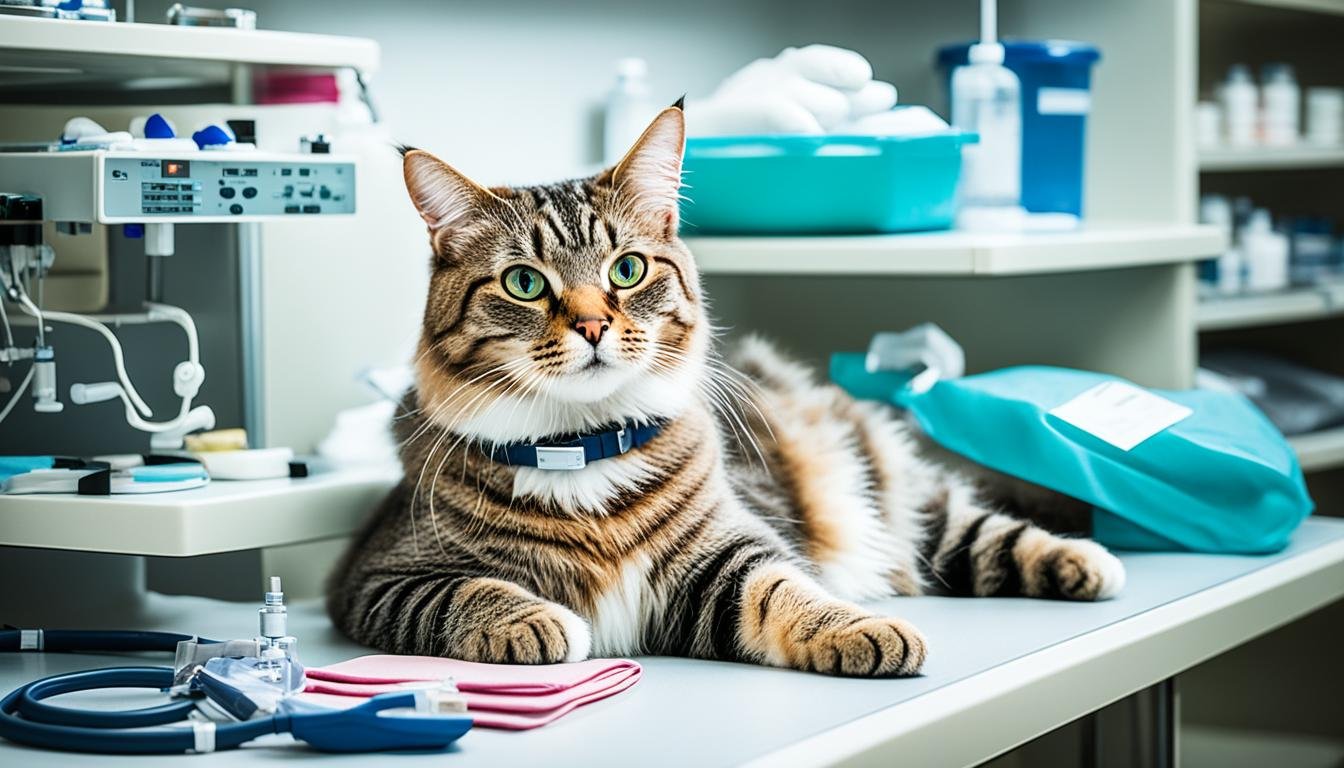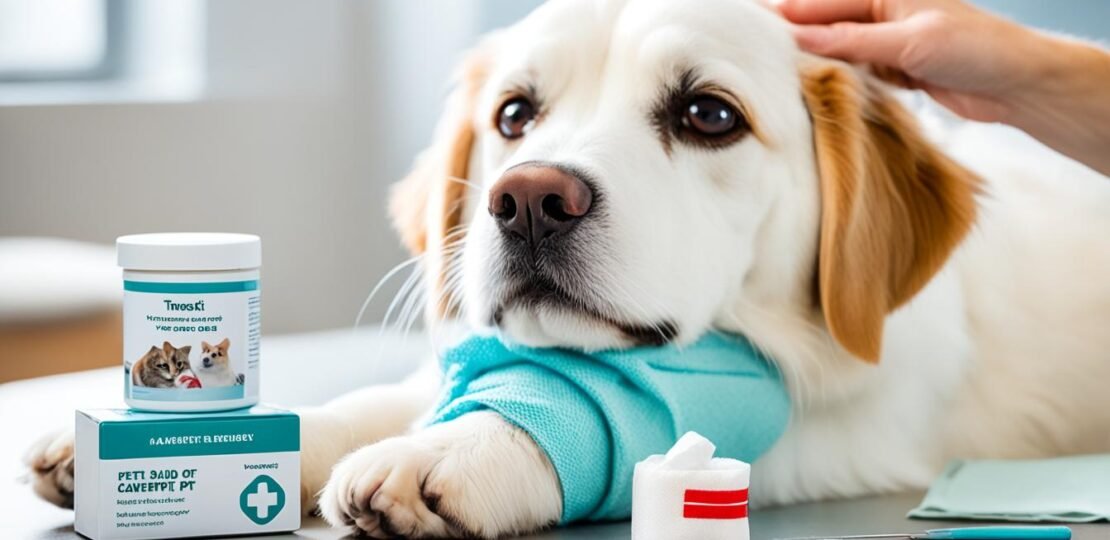
When it comes to our furry friends, their health and safety are of utmost importance. Knowing how to respond in pet health emergencies can mean the difference between life and death. In this section, we will provide you with essential first aid tips to help you handle emergency situations with confidence and ensure your pet receives the necessary care.
Accidents can happen at any time, and it’s crucial to be prepared. From cuts and scrapes to more serious injuries, pet first aid knowledge can greatly improve your pet’s chances of a full recovery. Whether it’s administering CPR or dressing a wound, having the right skills can be lifesaving.
Our dedicated team of experts has compiled a comprehensive guide on pet first aid, covering a range of topics including creating a pet emergency kit, administering medications, and identifying signs of pet poisoning. We’ll also provide step-by-step instructions on pet CPR and rescue breathing techniques.
By learning these essential pet first aid tips, you can be prepared to handle any pet health emergency that may arise. Whether it’s a cut paw, a toxic ingestion, or a cardiac arrest, your quick response and knowledge could be the key to saving your beloved pet’s life.
Stay tuned as we dive deeper into pet health emergencies, providing you with the information and guidance you need to ensure the well-being of your furry companion.
Understanding Pet Health Emergencies
Before diving into the specifics of pet first aid, it’s important to understand what constitutes a pet health emergency. Accidents and unexpected health issues can happen to our furry companions at any time, and knowing how to respond promptly and effectively can make all the difference in their well-being.
During a pet health emergency, time is of the essence. It’s crucial to recognize the signs that indicate immediate attention is needed and take appropriate action. Some common situations that require immediate veterinary care and attention include:
- Difficulty breathing or choking
- Severe bleeding or uncontrolled bleeding
- Unconsciousness or collapse
- Seizures or convulsions
- Excessive vomiting or diarrhea
- Sudden inability to walk or use limbs
- Pale gums or jaundice
- Swallowing a foreign object
Veterinary First Aid plays a crucial role in managing pet health emergencies. It involves providing immediate care to stabilize the pet’s condition until veterinary help is available. It encompasses various techniques and procedures, including CPR, wound management, and administering basic medications.
Pet Emergency Preparedness is another vital aspect of ensuring your pet’s safety during health emergencies. Taking proactive steps to prepare for potential emergencies can save precious time and potentially save your pet’s life. Some key measures to consider include:
- Keeping emergency contact numbers readily accessible
- Assembling a well-stocked pet emergency kit
- Knowing the location of the nearest emergency veterinary clinic
- Learning basic pet first aid techniques
- Creating a safe environment to minimize potential hazards
By understanding pet health emergencies, the importance of veterinary first aid, and taking proactive steps to be prepared, pet owners can ensure they are equipped to handle unexpected situations confidently. In the upcoming sections, we will delve deeper into specific first aid tips, emergency kits, CPR techniques, handling injuries, and more.
Creating a Pet Emergency Kit
A well-prepared pet emergency kit is crucial for any pet owner. Whether you have a curious cat or an adventurous dog, accidents and unexpected situations can happen at any time. Having a comprehensive emergency kit on hand can help you provide immediate care and potentially save your pet’s life.
When assembling your pet emergency kit, it’s important to include essentials that cover a range of possible scenarios. Here are the items that should be included:
| Essential Items for Your Pet Emergency Kit |
|---|
| 1. First aid supplies (such as sterilized gauze pads, adhesive tape, antiseptic solution) |
| 2. Pet-safe thermometer |
| 3. Muzzle or soft fabric strip for restraint |
| 4. Emergency contact information for your veterinarian and nearby animal hospitals |
| 5. Current medical records and vaccination certificates |
| 6. Blanket or towel for warmth and comfort |
| 7. Extra leash and collar |
| 8. Bottled water and food packaged for emergencies |
| 9. Medications your pet may require |
| 10. Pet carrier or crate for safe transportation |
Once you’ve gathered the necessary supplies, it’s important to store them in a safe and accessible location. Make sure to regularly check and replace any expired items to ensure the kit is always up to date.
Administering basic animal wound care is another essential skill every pet owner should know. When dealing with wounds, it’s crucial to act quickly and effectively.
Here are a few tips for administering basic animal wound care:
- Keep calm and reassure your pet to prevent further stress or injury.
- Wear gloves to protect yourself and prevent infection.
- Gently clean the wound with a saline solution or mild antiseptic.
- Apply a sterile dressing or bandage to protect the wound and control bleeding.
- Monitor the wound for signs of infection (redness, swelling, discharge) and seek veterinary care if necessary.
Remember, while basic wound care can be done at home, more severe injuries or wounds require immediate attention from a veterinarian.
Having a well-stocked pet emergency kit and the knowledge of basic animal wound care can help you handle unforeseen situations with confidence. By being prepared, you can provide the necessary care and potentially save your pet’s life.
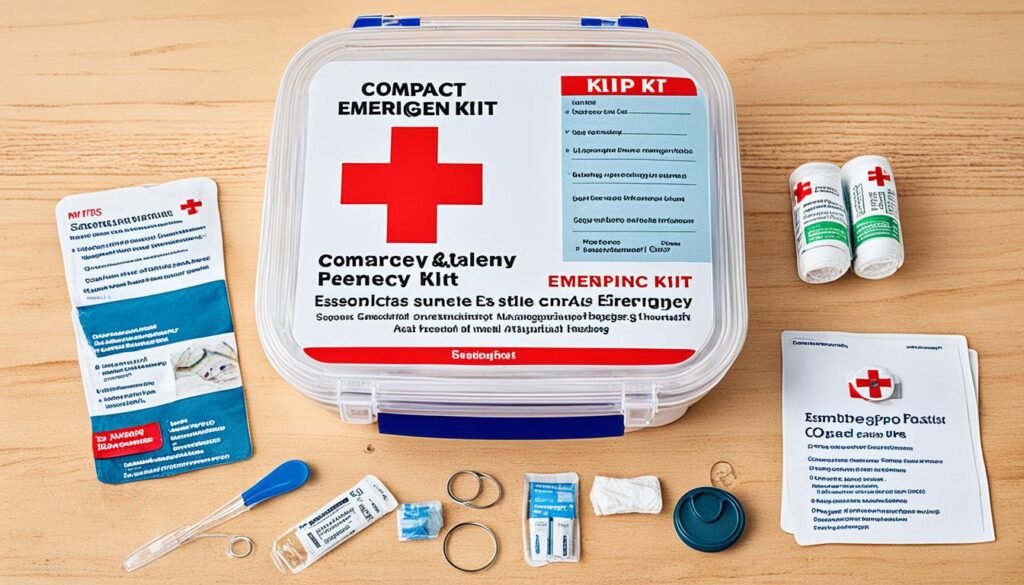
Expert Tip:
“Regularly check and update your pet emergency kit, especially regarding medications, food, and contact information. Staying prepared is key when it comes to handling pet health emergencies.”
Pet CPR and Rescue Breathing Techniques
Accidents can happen, and knowing pet CPR and rescue breathing techniques can make all the difference in saving your pet’s life. In a pet health emergency, being equipped with these life-saving skills can provide immediate care until veterinary help is available. Whether your pet is experiencing cardiac arrest or respiratory distress, prompt action can greatly increase their chances of survival.
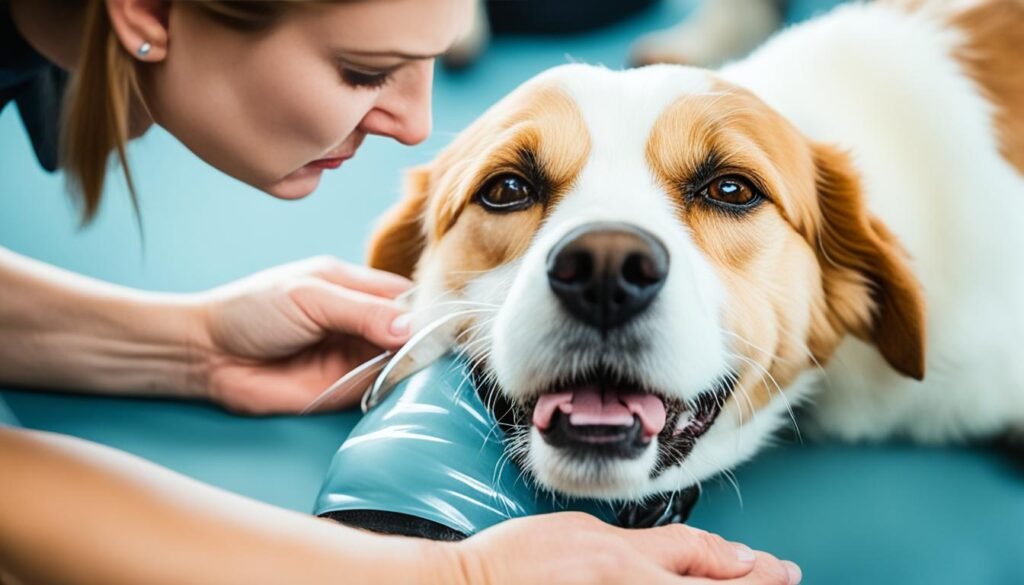
Step-by-Step Pet CPR Instructions
- Check for responsiveness:
- Gently tap your pet’s body and call their name.
- Observe their chest for movement or breathing. If your pet is unresponsive and not breathing, proceed to the next step.
- Position your pet:
- Lay your pet on their right side on a flat surface.
- If possible, gently extend your pet’s head and neck to ensure a clear airway.
- Perform chest compressions:
- Place one hand just behind your pet’s elbow and the other hand over it.
- Interlock your fingers and press down firmly, aiming to compress the chest by about one-third to one-half of its depth.
- Repeat this motion at a rate of approximately 100-120 compressions per minute.
- Perform rescue breaths:
- After every 30 compressions, give your pet two rescue breaths.
- Cover your pet’s nose with your mouth, ensuring a tight seal.
- Blow gently into the nostrils, watching for the rise and fall of the chest.
- Continue CPR until help arrives:
- Continue alternating between chest compressions and rescue breaths until your pet resumes breathing or professional veterinary assistance is available.
It’s important to note that pet CPR may vary depending on the size and species of your pet. Make sure to consult your veterinarian or enroll in a pet CPR course to learn the specific techniques for your furry friend.
Remember, mastering pet CPR and rescue breathing can offer peace of mind and potentially save your pet’s life in an emergency. Whether you’re at home or on the go, being prepared can make all the difference.
Dealing with Pet Injuries
Accidents happen, and it’s important for pet owners to know how to handle common pet injuries. Whether your furry friend has a small cut, a broken bone, or a burn, understanding proper injury treatment is crucial for their well-being.
Common Pet Injuries
Here are some of the most common pet injuries that you may encounter:
- Cuts and scrapes
- Bruises
- Fractures or broken bones
- Burns
- Eye injuries
- Paw injuries
While some injuries may be minor and can be treated at home, others require immediate veterinary care. It’s important to assess the severity of the injury and act accordingly.
Proper Injury Treatment
Here are some general guidelines for handling common pet injuries:
- Cuts and scrapes: Use clean water to rinse the wound and apply an antiseptic solution. If the bleeding doesn’t stop, apply gentle pressure with a clean cloth.
- Bruises: Apply a cold compress to reduce swelling and offer comfort to your pet.
- Fractures or broken bones: Immobilize the injured limb with a splint or bandage and seek immediate veterinary care.
- Burns: Flush the affected area with cool water and seek veterinary attention if the burn is severe.
- Eye injuries: Do not attempt to remove any foreign objects from the eye. Cover the eye gently with a clean, damp cloth and seek veterinary care.
- Paw injuries: Inspect the paw for cuts or foreign objects and clean the area thoroughly. Apply an antibacterial ointment and consider using a protective boot to prevent further damage.
Remember, every injury is unique, and it’s essential to consult a veterinarian for proper diagnosis and treatment. They will be able to provide you with specific instructions based on your pet’s condition.
When to Seek Veterinary Care
While minor injuries can often be managed at home, there are certain situations where immediate veterinary care is necessary:
“If your pet is bleeding excessively, shows signs of severe pain, has difficulty breathing, or has an injury that you are unsure how to handle, contact your veterinarian or the nearest 24-hour pet emergency clinic.”
Remember, prompt medical attention can make a significant difference in ensuring your pet’s recovery and well-being.
| Injury | Treatment |
|---|---|
| Cuts and scrapes | Rinse with clean water, apply antiseptic solution, monitor for infection |
| Bruises | Apply cold compress, observe for swelling or pain |
| Burns | Flush with cool water, seek veterinary care for severe burns |
| Fractures or broken bones | Immobilize with splint or bandage, seek immediate veterinary care |
| Eye injuries | Cover with damp cloth, seek veterinary care, do not remove foreign objects |
| Paw injuries | Clean thoroughly, apply antibacterial ointment, consider a protective boot |
Administering Medications and First Aid Supplies
Sometimes, in a pet health emergency, it becomes necessary to administer medications or provide first aid to your beloved furry friend. Being prepared with the right knowledge and supplies can make a significant difference in your pet’s well-being. In this section, we will discuss common medications and first aid supplies for pets, along with important guidelines for their proper use.
Common Medications for Pets
When it comes to pet health emergencies, having certain medications on hand can help you provide immediate relief or stabilize your pet’s condition before seeking professional veterinary care. Here are some common medications that are commonly used:
- Antihistamines: These can help alleviate mild allergic reactions or insect bites. However, always consult with your veterinarian before administering any medication.
- Anti-inflammatory drugs: These medications can help reduce pain and inflammation in pets suffering from musculoskeletal injuries or arthritis. Again, it’s important to consult your vet for proper dosage and administration.
- Antibiotics: Prescribed antibiotics are essential for treating bacterial infections. Never use antibiotics without veterinary guidance to prevent unnecessary side effects or antibiotic resistance.
- Pain relief medications: For severe injuries or post-surgical care, your veterinarian may prescribe pain medications to manage your pet’s discomfort. Strictly follow the prescribed dosage and instructions.
First Aid Supplies for Pets
Having a well-stocked first aid kit can help you provide immediate care and minimize the impact of an emergency situation. Here are some essential first aid supplies every pet owner should have:
- Bandages and dressings: These are crucial for covering wounds and controlling bleeding. Make sure you have an assortment of bandage sizes and adhesive tapes.
- Gauze pads: Gauze pads are useful for cleaning wounds or applying pressure to control bleeding. Stock up on sterile gauze pads for your pet’s first aid kit.
- Hydrogen peroxide: This can be used to induce vomiting if your pet ingests something potentially harmful. However, consult your vet or a pet poison control hotline before administering.
- Tweezers and scissors: These tools are handy for removing splinters, debris, or trimming hair around wounds. Ensure they are clean and sterile before use.
- Saline solution: Saline solution can be used to flush out wounds or clean your pet’s eyes if they are irritated or contaminated. Avoid using other substances like hydrogen peroxide in your pet’s eyes.
Remember, while having medications and first aid supplies is essential, it’s crucial to consult your veterinarian before administering any treatments. They can provide specific guidance based on your pet’s health condition and medical history.
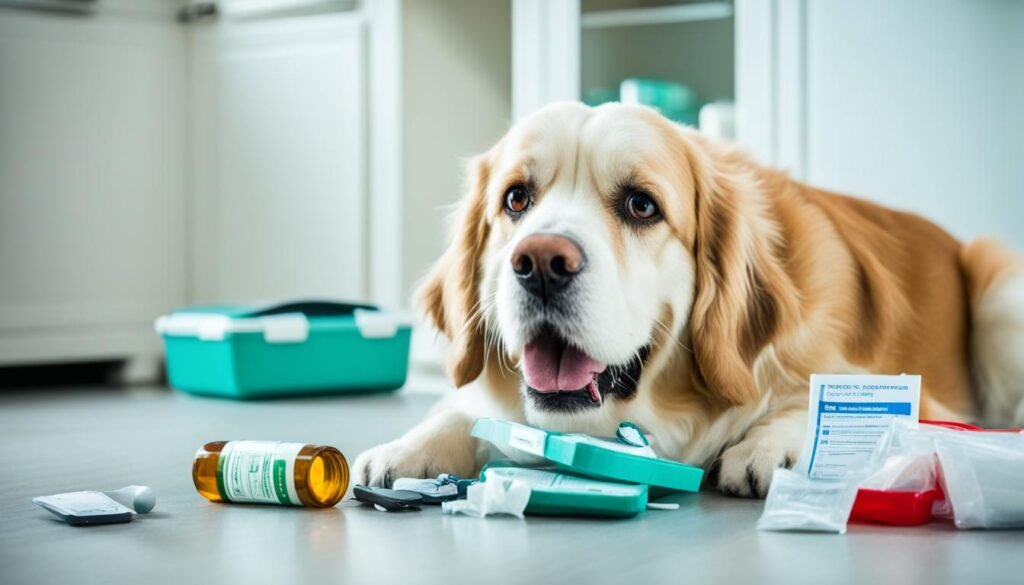
“Administering medications and providing first aid can be life-saving in a pet health emergency. However, always consult your veterinarian for proper guidance and treatment to ensure your pet’s safety and well-being.”
Identifying Signs of Pet Poisoning
Poisoning can be a serious pet health emergency that requires immediate veterinary first aid. It’s crucial for pet owners to be able to recognize the signs of poisoning and take proactive steps to ensure their pet’s well-being. In this section, we’ll discuss common household toxins, symptoms of pet poisoning, and what actions to take in case of poisoning.
Common Household Toxins
It’s important to be aware of the potential hazards in your home that can pose a risk to your pet’s health. Common household toxins include:
- Certain human medications
- Household cleaners and chemicals
- Plants
- Food toxic to pets, such as chocolate, grapes, and onions
Being knowledgeable about these toxins can help you prevent accidental pet poisoning.
Symptoms of Pet Poisoning
Recognizing the symptoms of pet poisoning is crucial for taking immediate action. Some common signs of poisoning in pets include:
- Vomiting and diarrhea
- Lethargy and weakness
- Loss of appetite
- Drooling or excessive thirst
- Difficulty breathing
If you notice any of these symptoms or suspect that your pet has ingested something toxic, it’s important to act quickly.
Steps to Take in Case of Poisoning
If you believe your pet has been poisoned, follow these steps:
- Remove your pet from the source of poisoning: If the toxin is still accessible, safely remove your pet from the area to prevent further exposure.
- Contact your veterinarian: Call your veterinarian or a pet emergency care clinic for immediate guidance and instructions.
- Provide information: Be prepared to provide details about the toxin, including its name, ingredients, and the estimated amount your pet may have ingested.
- Do not induce vomiting: In some cases, inducing vomiting can worsen the situation. It’s important to follow the advice of your veterinarian.
- Follow veterinary advice: Your veterinarian may recommend specific actions to take, such as administering activated charcoal or bringing your pet in for immediate treatment.
Remember, pet poisoning can be a life-threatening emergency, so it’s crucial to seek veterinary care as soon as possible.
| Poisoning Symptoms | Immediate Action |
|---|---|
| Vomiting and diarrhea | Call a veterinarian for guidance |
| Lethargy and weakness | Remove your pet from the source of poisoning |
| Loss of appetite | Provide information about the toxin to your veterinarian |
| Drooling or excessive thirst | Follow veterinary advice for immediate treatment |
| Difficulty breathing | Do not induce vomiting; seek immediate veterinary care |
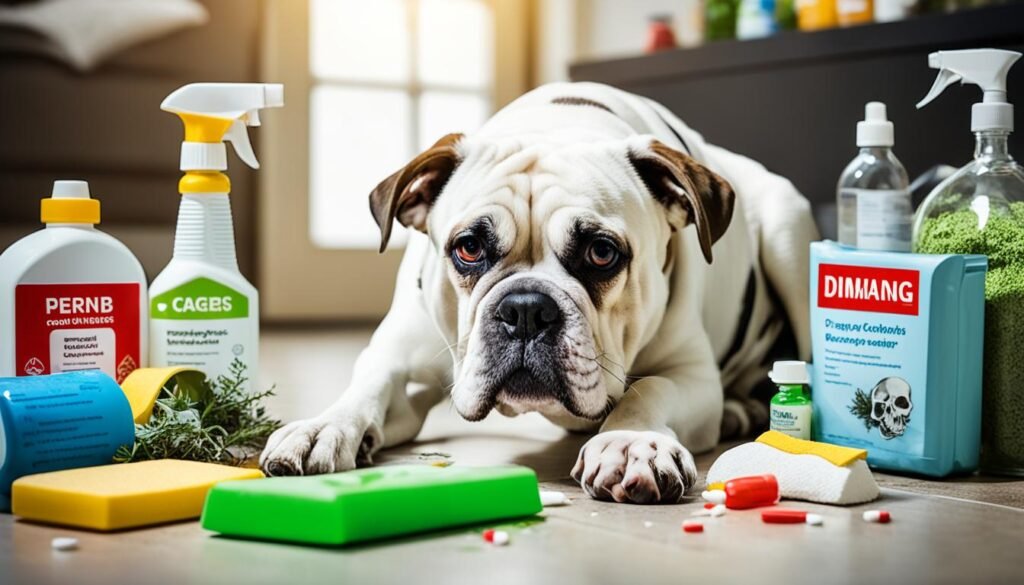
Being able to identify the signs of pet poisoning and taking immediate action can greatly improve the chances of a positive outcome. By being aware of common household toxins, recognizing symptoms of poisoning, and knowing the steps to take in case of poisoning, you can provide the necessary veterinary first aid and emergency care for your beloved pet.
Finding Professional Veterinary Care
While knowing pet first aid is essential, it’s also important to have access to professional veterinary care during emergencies. Your veterinarian plays a crucial role in providing the necessary expertise and resources to ensure the health and well-being of your furry friend.
In the event of a pet health emergency, time is of the essence. It’s crucial to have a trusted veterinarian who can promptly address the situation and provide the appropriate care. Make sure to have the contact information of your local veterinary clinic readily available, including their phone number and address, so you can quickly reach out in case of an emergency.
When it comes to choosing a veterinarian, several factors should be considered. Look for a reputable clinic that specializes in pet emergency care and offers veterinary first aid services. Consider the clinic’s location, availability of after-hours emergency care, and the expertise and experience of the veterinarians and staff.
Additionally, it can be helpful to seek recommendations from other pet owners or consult online reviews to gauge the quality of care provided by a particular veterinary clinic. You want to ensure that your chosen veterinarian not only has the necessary expertise but also demonstrates compassion and provides a supportive environment during stressful situations.
FAQ
What should I do if my pet is injured?
How can I create a pet emergency kit?
Can I perform CPR on my pet?
What should I do if my pet ingests something harmful?
How do I know if my pet is experiencing a health emergency?
How should I administer medications to my pet?
What should I do if my pet is poisoned?
How can I find a reliable veterinarian for my pet?
RELATED POSTS
View all
